Looks like GIGABYTE has really upped the game on the new Nvidia GeForce GTX 650 Ti. Check out how they have an edge over their competition with extra features other cards do not offer.
Introduction
As you might have heard, Nvidia just released their latest Kepler graphics card, the Nvidia GeForce GTX 650 Ti. Performance wise, this video card fall right in between the Nvidia GeForce GTX 650 and the GTX 660. We took a detailed overview look at the reference card in our official GeForce GTX 650 Ti review, so if you haven’t checked it out yet, feel free to do so. To sum up the key features of the reference design, Nvidia decided to go with 768 CUDA cores along with a 925 MHz Core Clock Speed, 5400 MHz memory frequency, and 1GB of GDDR5 VRAM. Now the Nvidia GeForce GTX 650 Ti is powered by the same GK106 GPU that was first implemented in the GeForce GTX 660. This means that the GPU can support up to 4 display outputs, which was not available on the reference design card. With this background information, now we can understand why GIGABYTE’s latest GeForce GTX 650 Ti OC graphics card stands out from the crowd.
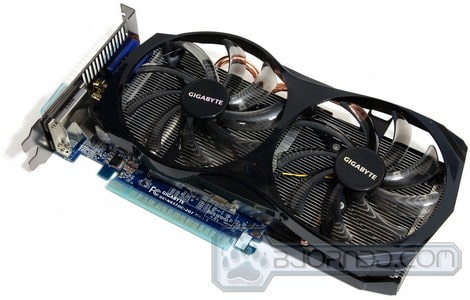
The new GIGABYTE GTX 650 Ti OC video card that we’re taking a look at today comes with a massive 2GB frame buffer or video memory, which can provide a great performance increase in games that require lots of VRAM for textures, anti-aliasing, and high resolutions. Some might consider this useless, but certain games such as The Elder Scrolls V: Skyrim doesn’t require much graphics rendering, while it can use up way over 2GB of VRAM if the game is modded with high-resolution textures and mesh improvements. 1GB cards would be struggling big time in accomplishing a smooth gameplay with user modified content that Skyrim offers. In some cases games crash, when there is not enough video memory available to them.
The GIGABYTE GTX 650 Ti OC video card also has another great improvement over the reference card. This is the inclusion of the 4 display ports that was missing on the reference design, and its dual-fan heatsink design. We’ll go into more detail about the specific display output ports and the cards cooling capability in our product overview below. However, with the higher video memory available on this card, the 4 display output ports, the factory overclock on this card, and the new cooler design does raise the prices a tad bit. While the MSRP for the GTX 650 Ti is $149.99, the GIGABYTE GTX 650 Ti OC 2GB graphics card will go for $174.99 with a free copy of Assassin’s Creed III. GIGABYTE does offer a standard 1GB version of the card with same overclocked specifications, which costs $154.99. If you don’t need the 2GB version of the card, you should definitely go with the 1GB version and save a few dollars during your purchase. We have also taken a look at MSI’s GeForce GTX 650 Ti Power Edition 1GB video card, which is slightly underclocked from the GIGABYTE GTX 650 Ti OC video card, but comes with a different cooler design, 3 display outputs, but still costs $159.99. So it’s good to take a look at which card offers the features you need, and decide on your purchase that way.
Features & Specifications
Taking a closer look at the actual specifications of the GIGABYTE GTX 650 Ti OC graphics card reveals that the card has been overclocked by 107 MHz from factory stock settings to 1032 MHz. This should give a little more frames per second to each game, providing a much smoother gameplay, which might have been slightly laggy on a stock card. The improvements won’t be big, but faster performance is always welcome. As mentioned above, this card is the only card we have so far tested that comes with a 2GB VRAM, so it will be interesting to see the results on how this card actually compares to the other cards we have tested.
| Specifications | Nvidia GTX 650 (Reference) |
Nvidia GTX 650 Ti (Reference) |
MSI GTX 650 Ti Power Edition |
GIGABYTE GTX 650 Ti OC 2GB |
| CUDA Cores (Stream Processors) |
384 | 768 | 768 | 768 |
| Bus Interface | PCI-Express 3.0 | PCI-Express 3.0 | PCI-Express 3.0 | PCI-Express 3.0 |
| Texture Units |
32 | 64 | 64 | 64 |
| ROPs |
16 | 16 | 16 | 16 |
| SMXs |
2 | 4 | 4 | 4 |
| Core Clock | 1058 MHz | 925 MHz | 993 MHz | 1032 MHz |
| Boost Clock |
N/A | N/A | N/A | N/A |
| Memory Clock |
5000 MHz Effective | 5400 MHz Effective | 5400 MHz Effective | 5400 MHz Effective |
| L2 Cache Size |
x KB | 256 KB | 256 KB | 256 KB |
| Memory Bus Width |
128 Bit | 128 Bit | 128 Bit | 128 Bit |
| Total Memory Bandwidth |
80.0 GB/s | 86.4 GB/s | 86.4 GB/s | 86.4 GB/s |
| Texture Fill Rate (Bilinear) |
33.9 GT/s | 59.2 GT/s | 59.2 GT/s | 59.2 GT/s |
| VRAM | 1GB (GDDR5) | 1GB (GDDR5) | 1GB (GDDR5) | 2GB (GDDR5) |
| SLI Ready | N/A | N/A | N/A | N/A |
| TDP | 64W | 110W | 110W (80W TDP according to MSI Headquarters) | 110W |
| Recommended Power Supply | 400W+ | 400W+ | 400W+ | 400W+ |
| Power connectors | 1x 6-Pin PCI-E | 1x 6-Pin PCI-E | 1x 6-Pin PCI-E | 1x 6-Pin PCI-E |
| Outputs | Dual Link-DVI-I, Dual Link DVI-D, Mini HDMI | Dual Link-DVI-I, Dual Link DVI-D, Mini HDMI | Dual Link-DVI-I, Dual Link DVI-D, Mini HDMI | Two Dual Link DVI-D, HDMI, D-Sub |
| Manufacturing Process |
TSMC 28nm | TSMC 28nm | TSMC 28nm | TSMC 28nm |
| Thermal Threshold | 98C | 98C | 98C | 98C |
| Launch Price | $109.99 (MSRP) | $149.99 (MSRP) | $159.99 (MSRP) | $169.99 (MSRP), $174.99 w/ Free Assassins Creed 3 Bundle |
Product Overview
Click Images to Enlarge
The front of the GIGABYTE GTX 650 Ti OC 2GB video card makes a clear difference between the 1GB and 2GB version of the card available on the market. The front package also shows off the windforce design cooler and that the card is overclocked. The back of the box takes a look at some of the specifications of the cooler and the video card, and also talks about the Ultra Durable 2 components that users will find used on this particular video card.
Click Images to Enlarge
Inside the box you’ll find some accessories and the actual card. As we can see, the card is protected by air pockets, which means that if the box takes a direct a hit, the air pockets created inside the packaging will protect the card from getting damaged. Unfortunately, not many accessories are given with the card. Probably not a big issue and we’ll explain why. While we are expected to see some display output adapters, it is not a necessity with this particular card. Other cards like the MSI GeForce GTX 650 Ti Power Edition came with the adapters due to having a mini-HDMI port and for not having a D-Sub/VGA port. The GIGABYTE GeForce GTX 650 Ti OC 2GB card comes with both of these display outputs already, which means that no adapters are required and the same outputs will be available to the user. The included accessories are: a Quick Installation guide, a PWM to 6-Pin PCI-E power connector adapter, and a Driver CD.
Click Images to Enlarge
If you are familiar with GIGABYTE’s windforce cooler design, then it should be nothing new to you. The card comes with a dual-fan design, which should help provide a much quieter cooling over a single fan design card. The reason being is because GIGABYTE is able to achieve the same or better cooling potential by running to lower RPM fans, reducing air and motor noise over the single fan cards that might require to use higher RPMs to get the same cooling done. The cooler design is not too appealing to us, however, we’ll check out how this cooler design actually works when it comes to testing the card.
Click Images to Enlarge
As we might have seen from previous pictures, the GIGABYTE GTX 650 Ti OC 2GB video card comes with small plastic rubber covers that protect all the connectors on the card, including the PCI-Express slot connector, and the display output connectors in the back. This is a nice feature, because you can be sure that nothing has scratched the main PCI-E connector golden fingers or no dust has entered the display ports. These are very cheap additions to the card that should not change the overall price of the card, but will give more overall quality to the user.
We have 4 display outputs on the GIGABYTE GTX 650 Ti OC card. These include: Two Dual-Link DVI-D, an HDMI, and D-Sub/VGA port.
Click Images to Enlarge
Taking a closer look at the card’s design, we can see that the video card has 4 additional memory modules attached on the back of the PCB. This is obviously not available on the 1GB versions of the card, as those memory modules were left out on purpose to save on cost. We can also see that there is no SLI support on this video card. Unfortunately, this was a decision that Nvidia made, and GIGABYTE cannot really change the design of the card, since the GTX 650 Ti was not designed to be run in SLI. From these angles, we can also get a bit more understanding of the cooler on this video card. We can see the actual PCB size is much smaller, which is why the 6-Pin PCI-E power connector on this card is located almost towards the middle of the card. The cooler comes with two copper heatpipes that go straight to the GPU to have direct contact with it. These heatpipes spread the heat across many aluminum fins which then the two fans cool down to cool the processor. However, one thing to notice is that the cooler does not actually touch the memory modules on the card. This means that only the GPU will be cooled by the heatsink, and the memory modules will only be cooled by the airflow being blown through the card.
Testing Methodology
The OS we use is Windows 8 Pro 64bit (Retail) with all patches and updates applied. We also use the latest drivers available for the motherboard and any devices attached to the computer. We do not disable background tasks or tweak the OS or system in any way. We turn off drive indexing and daily defragging. We also turn off Prefetch and Superfetch. This is not an attempt to produce bigger benchmark numbers. Drive indexing and defragging can interfere with testing and produce confusing numbers. If a test were to be run while a drive was being indexed or defragged, and then the same test was later run when these processes were off, the two results would be contradictory and erroneous. As we cannot control when defragging and indexing occur precisely enough to guarantee that they won’t interfere with testing, we opt to disable the features entirely.
Prefetch tries to predict what users will load the next time they boot the machine by caching the relevant files and storing them for later use. We want to learn how the program runs without any of the files being cached, and we disable it so that each test run we do not have to clear pre-fetch to get accurate numbers. Lastly we disable Superfetch. Superfetch loads often-used programs into the memory. It is one of the reasons that Windows Vista occupies so much memory. Vista fills the memory in an attempt to predict what users will load. Having one test run with files cached, and another test run with the files un-cached would result in inaccurate numbers. Again, since we can’t control its timings so precisely, it we turn it off. Because these four features can potentially interfere with benchmarking, and and are out of our control, we disable them. We do not disable anything else.
We ran each test a total of 3 times, and reported the average score from all three scores. Benchmark screenshots are of the median result. Anomalous results were discounted and the benchmarks were rerun.
Please note that due to new driver releases with performance improvements, we rebenched every card shown in the results section. The results here will be different than previous reviews due to the performance increases in drivers.
Test Rig
| Test Rig | |
| Case | Cooler Master Storm Trooper |
| CPUs | Intel Core i7 3960X (Sandy Bridge-E) @ 4.6GHz |
| Motherboards | ASUS P9X79 WS X79 Chipset Motherboard |
| Ram | Kingston HyperX Genesis 32GB (8x4GB) 1600Mhz 9-9-11-27 Quad-Channel Kit |
| CPU Cooler | Noctua NH-D14 Air Cooler |
| Hard Drives | 2x Western Digital RE3 1TB 7200RPM 3Gb/s Hard Drives in RAID 0 |
| SSD |
|
| Optical | ASUS DVD-Burner |
| GPU |
|
| PSU | Cooler Master Silent Pro Gold 1200W PSU |
| Mouse | Razer Imperator Battlefield 3 Edition |
| Keyboard | Razer Blackwidow Ultimate Battlefield 3 Edition |
Synthetic Benchmarks & Games
| Benchmarks |
|---|
| 3DMark 11 |
| Just Cause 2 |
| Lost Planet 2 |
| Metro 2033 |
| Battlefield 3 |
| Unigine Heaven 3.0 |
| Batman Arkham City |
| Dirt 3 |
Synthetic Benchmarks
3DMark 11
The GIGABYTE GTX 650 Ti OC 2GB video card really jumps ahead of the competition. As we can see from our first 3DMark 11 benchmark results, the GIGAYTE GTX 650 Ti managed to outperform both the reference and the factory overclocked MSI video card. Also, in our performance test, the GIGTABYTE GTX 650 Ti OC managed to outperform the last generation factory overclocked Palit GTX 560 Ti Sonic, which used to go for $259.99 a year and a half ago.
Unigine Heaven 3.0
Unigine Heaven is a benchmark program based on Unigine Corp’s latest engine, Unigine. The engine features DirectX 11, Hardware tessellation, DirectCompute, and Shader Model 5.0. All of these new technologies combined with the ability to run each card through the same exact test means this benchmark should be in our arsenal for a long time.
Once again, we see the GIGABYTE GTX 650 Ti OC card take first place amongst the other GTX 650 Ti cards. It also managed to get up to 7.9FPS gain over the HD 7770 at a 1680×1050 resolution, and a 6.8FPS gain at 1920×1080. Quite impressive.
Game Benchmarks
Battlefield 3
In our Battlefield 3 results, we found a very interesting performance difference between 1680×150 and 1920×1080 resolutions on the GIGABYTE GTX 650 Ti OC 2GB card compared to the other GTX 650 Ti 1GB cards. We would like to think this difference is due to the 2GB frame buffer on the GIGABYTE card, however, we cannot prove this just by only running a benchmark on Battlefield 3. We’ll check out other games as well that also use lots of video memory to see how those games ract to a card that has 2GB of video memory.
Metro 2033
Metro 2033 is another game that uses quite a bit of video memory during gameplay. However, we were not able to see much performance difference between the other cards, besides the performance the GIGABYTE GTX 650 Ti had due to the higher Core Clock speed on the card.
Batman Arkham City
In Batman Arkham City, we once again see the great performance improvements on the Kepler architecture implemented in the 6xx series graphics cards from Nvidia. The previous generation Fermi cards, such as the GTX 580, which used to go for over $500 when it got first released had only a 11FPS performance difference from the GIGABYTE GTX 650 Ti OC 2GB card. This is not a surprise, because last month when we tested EVGA’s GTX 660 SC card, there was an even bigger difference in performance surpassing the GTX 580 by 18FPS. Either way, the game is fully enjoyable at these frame rates, even at maximum graphics settings without PhysX enabled.
Just Cause 2
Just Cause 2 on the other hand is a game that doesn’t like the new Kepler architecture, and AMD cards seem to have higher scores compared to the Nvidia cards of the same caliber. While we saw the HD 7770 take over the GTX 650 Ti reference design card, it did not manage to take over the GIGABYTE GTX 650 Ti OC 2GB Card. We saw a nice 6FPS difference between the reference card and the GIGABYTE card, and about 5FPS difference between the HD 7700 and the GIGABYTE GTX 650 Ti OC.
Lost Planet 2
While the reference card only managed 36.6FPS in Lost Planet 2 maxed out in graphics settings at 1920×1080, the GIGABYTE GTX 650 Ti got up to 41FPS with the same settings. This makes the game way more enjoyable especially in the graphical intensive parts where the stock GTX 650 Ti might make the game too choppy to play. If we would have the scores for the AMD HD 7850, we might see similar results as well, considering that the AMD HD 7870 was only 7 FPS apart from the GIGABYTE GTX 650 Ti OC 2GB.
Dirt 3
Just like Lost Planet 2, Dirt 3 shows a big improvement in performance with the GIGABYTE GTX 650 Ti OC over the stock reference card. The game was maxed out on Ultra High settings, and it as still 100% playable, no matter what you threw at it.
Other Stability Tests
TEMPERATURES
To measure the temperature of the video card, we used EVGA’s Precision X and ran the Metro 2033 benchmark in a loop to find the Load temperatures for the video cards. The highest temperature was recorded. After looping for 10 minutes, Metro 2033 was turned off and we let the computer sit at the desktop for another 10 minutes before we measured the idle temperatures.
While the GIGABYTE GTX 650 Ti OC 2GB video card was the fastest GTX 650 Ti we have tested till now, it is also the coolest card under the factory overclocked settings. At full load, the card only got up to 48C. This is excellent as every degree difference in temperature can help keep a card stable, and also functional for a much longer time. One thing we have noticed though was that the video card’s windforce cooler would not be as efficient at cooling when the video card got overclocked. Also, changing the fan speed from AUTO to 100% did not gain us much difference in cooling potential. The card was still fairly quiet even at 100% fan speeds.
POWER CONSUMPTION
To get our power consumption numbers, we plugged in our Kill A Watt power measurement device and took the Idle reading at the desktop during our temperature readings. We left it at the desktop for about 15 minutes and took the idle reading. Then we ran Metro 2033 for a few minutes minutes and recorded the highest power usage.
The card excelled very well in performance and cooling, but it’s power consumption is another thing. The GIGABYTE GTX 650 Ti OC had the highest power consumption from all the GTX 650 Ti cards we have tested. A bummer, but not a deal breaker, as it still uses a lot less power over a GTX 660.
Overclocking
Overclocking was done with Precision X overclocking utility. We first raised the voltage on the card to 1065mv, which was the maximum voltage available on the GIGABYTE GTX 650 Ti OC 2GB. The MSI GTX 650 Ti Power Edition video card allowed up to 1075mv, therefore the overclocking potential was better on the MSI card. The Core Clock speed was ultimately raised up to 1148 MHz and the memory frequency to 5814 MHz. Those were the highest stable overclocked settings.
Results:
| 3DMark Score | GPU Score | Combined Score | |
| Nvidia GeForce Reference | 4733 | 4344 | 3577 |
| MSI GTX 650 Ti Power Edition (1220/5930) | 5787 | 5365 | 4493 |
| GIGABYTE GTX 650 Ti OC 2GB (1148/5814) | 5567 | 5150 | 4287 |
Conclusion
Due to its great performance in almost any video game we have tested in our labs, the GIGABYTE GeForce GTX 650 Ti will find its way into our main system at home. We won’t be using it as a dedicated card for rendering all the graphics in our video games, because we have our Nvidia GeForce GTX 690 for that. Instead, we’ll be using this specific card for a dedicated PhysX card, as soon as Nvidia releases a new set of drivers for the GTX 650 Ti, which will allow us to utilize this card as a dedicated PhysX card. Don’t get me wrong, this card is banging compared to its red competition, as well as against other manufacturers that also sell GTX 650 Ti graphics cards!
So let us break it down a bit. As we have seen from the video card overview, and its performance, this card is not designed for extreme gamers, unless you will end up using the card like we will in our main system as a dedicated PhysX card. The reference GTX 650 Ti comes in a 1GB model, along with a 925 MHz Core Clock, and 3 display outputs. Other manufacturers like MSI have pushed their cards to higher Core Clock frequencies, but still not as high as GIGABYTE. While ASUS on the other hand had the same Core clock speeds, but did not have a 2GB version of the card. This makes the GIGABYTE GTX 650 Ti OC 2GB video card unique from the rest of the cards. Sure each of the vendors has their own cooler design, along with GIGABYTE having their dual-fan Windforce design. But when it comes to what the card can offer, GIGABYTE still has its edge over the competition.
On the other hand, while the cooling potential of the video card was great at factory overclocked settings, as soon as we overclocked the card to its maximum stable frequencies, the cooler was not as efficient anymore, and MSI’s GTX 650 Ti Power Edition card ended up beating the GIGABYTE GTX 650 Ti in cooling. We were also not too satisfied with the out of the box overclocking potential of the card. The voltage settings were limited to 1065mv, and this prevented us from pushing the Core Clock frequency higher. Needless to say, we still have a beast of a card here today, and for the price of $174.99 with a free game bundle of Assassin’s Creed III, this card is worth every penny.
| OUR VERDICT: GIGABYTE GeForce GTX 650 Ti 2GB OC | ||||||||||||||||||
|
||||||||||||||||||
| Summary: The GIGABYTE GTX 650 Ti OC 2GB video card is the fastest, coolest, and quietest video card we have tested from the GTX 650 Ti lineup so far. It also comes with 4 display outputs, and 2GBs of VRAM, making it a great card for even games that use a lot of video memory. The card is not designed for enthusiasts, but will definitely make any budget gamer happy! This is why GIGABYTE’s GTX 650 Ti OC 2GB graphics card deserves Bjorn3D’s Golden Bear Award! |
 Bjorn3D.com Bjorn3d.com – Satisfying Your Daily Tech Cravings Since 1996
Bjorn3D.com Bjorn3d.com – Satisfying Your Daily Tech Cravings Since 1996


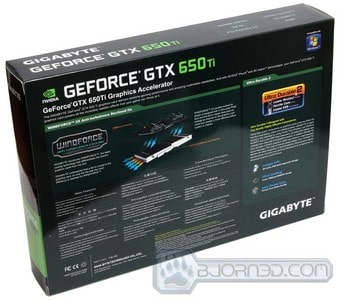

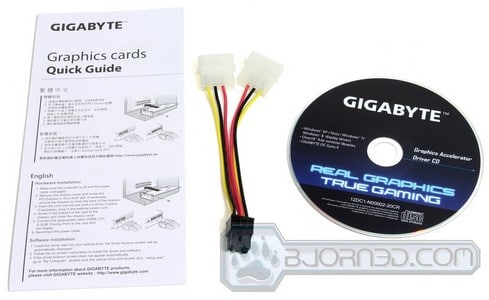
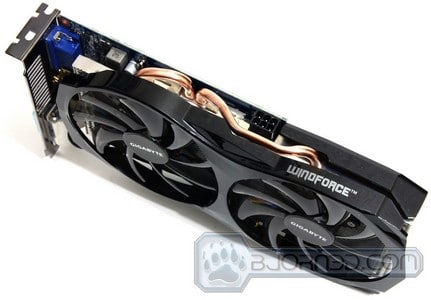
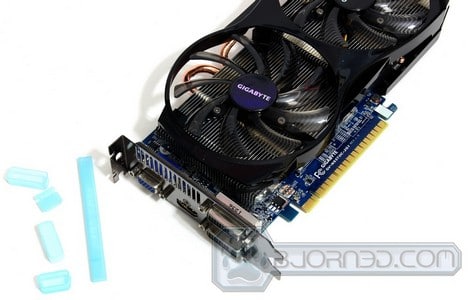
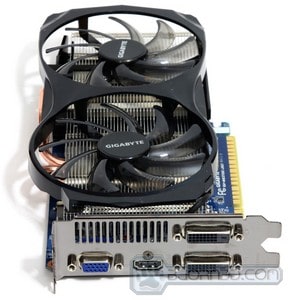
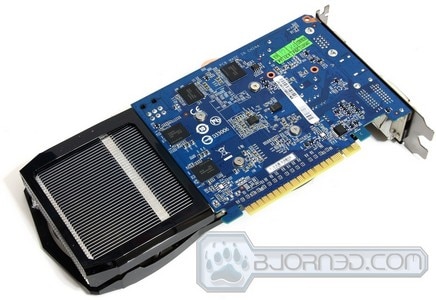





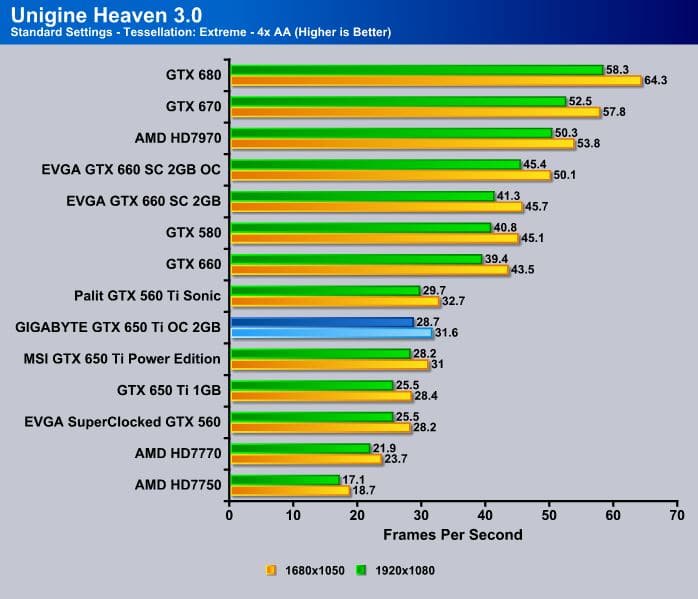

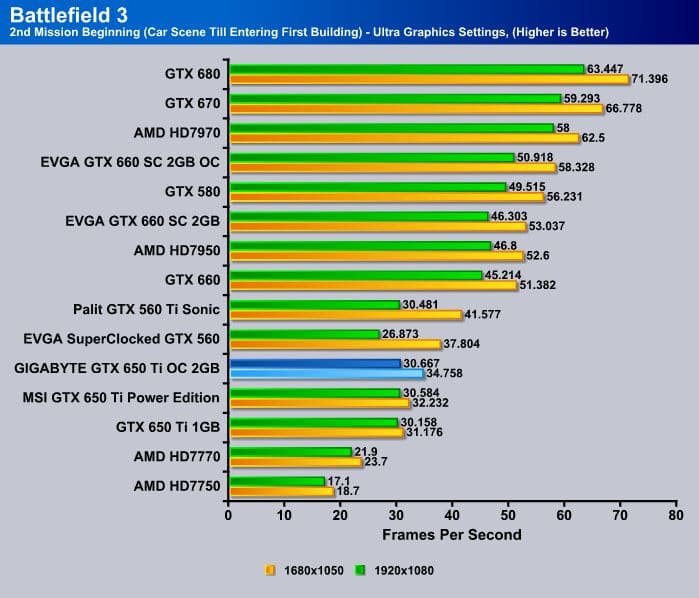



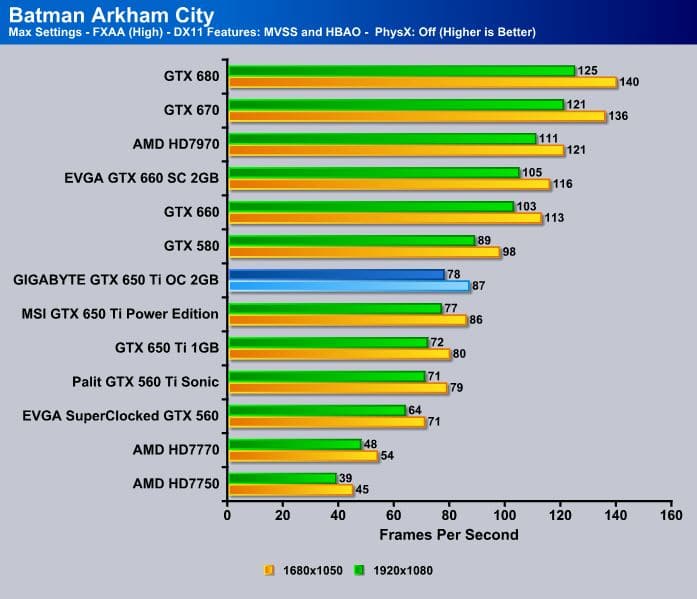

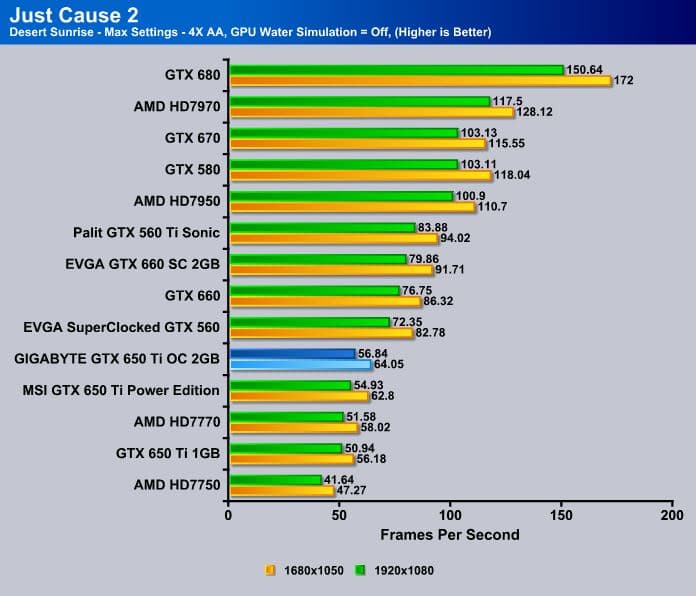









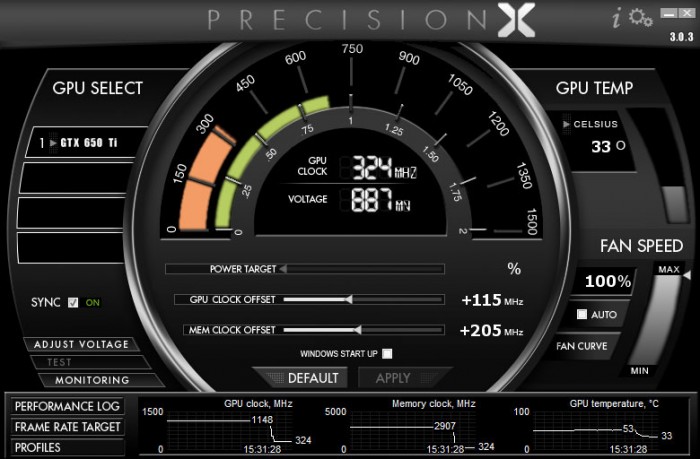

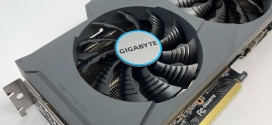






Huh… I am a bit confused… You gave it 3×8 and 2×8.5, right? So how does that transform into a 9??
You don’t know math, that’s for sure. And we know Nvidia is surely paying for these reviews.
You purposefully left out the Radeon HD7850 which you can find for as low as $149.99 and it simply BLOWS this one out of the water…
You “reviewers” should have the minimum of ethical sense. This card is worthless. It has no place in the current market and you go around saying how good it is?? Shame on you for misleading less informed consumers…
Hi Manny, If you have not noticed in our scoring, we have a disclaimer for the Total Score: “We are using a new addition to our scoring system to provide additional feedback beyond a flat score. Please note that the final score isn’t an aggregate average of the new rating system.” With that said, we rate cards in their categories, therefore from all the GTX 650 Tis we found the GIGABYTE one to be the most worthy of the Gold Award and a 9/10 compared to the other cards. You are right about the 7850 performing better in certain games compared to the GTX 650 Ti, what you’re wrong about is the price. Most 7850s which blow the 650 Ti out of the water cost over $179.99+, which is definitely more expensive than this card. So as far as price vs. performance goes, the cards are very comparable. Look at our other 7850 reviews and you’ll see those have higher scores, so we did not give the GIGABYTE GTX 650 Ti OC 2GB a score that would not make sense. Have a wonderful weekend, and thank you for your comment!
Hi Manny, If you have not noticed in our scoring, we have a disclaimer for the Total Score: “We are using a new addition to our scoring system to provide additional feedback beyond a flat score. Please note that the final score isn’t an aggregate average of the new rating system.” With that said, we rate cards in their categories, therefore from all the GTX 650 Tis we found the GIGABYTE one to be the most worthy of the Gold Award and a 9/10 compared to the other cards. You are right about the 7850 performing better in certain games compared to the GTX 650 Ti, what you’re wrong about is the price. Most 7850s which blow the 650 Ti out of the water cost over $179.99+, which is definitely more expensive than this card. So as far as price vs. performance goes, the cards are very comparable. Look at our other 7850 reviews and you’ll see those have higher scores, so we did not give the GIGABYTE GTX 650 Ti OC 2GB a score that would not make sense. Have a wonderful weekend, and thank you for your comment!
Why are there no comparisons to the 7850 which outperforms it at pretty much the same price point?
Why does every AMD fanboy claim the 7850 is the same price as the 650Ti? It is not true. I tried and tried to find a 7850 to replace my 5850, But every place I looked was asking around $170-$180 for the 7850, So I just bought the 650 Ti reference base MSI model for $119. The 650Ti was much cheaper and has close to the same performance. Not to mention the 650Ti has much better driver support, So the 650Ti will actually perform much smoother than the 7850. I have no idea what happened to AMD’s driver developers. But as soon as I started playing games with the 650Ti after using my 5850 since 2010, I noticed a massive improvement. Honestly I would not take a AMD GPU now if somebody gave it to me.
I did however find and purchased me a new HIS R9 270 iPower IceQ X² Boost Clock for $179, Great price and great performance. AMD has done better with their new R7 and R9 series cards in pricing. I have no idea why the 7850 was so overpriced. But I am glad I got my new R9 series card. My 650 Ti is a great card, But my new R9 270 creams it. Plus I still got my 650Ti as a spare.
so for this specific graphics card, would the card be ideal for first person shooter games like battlefield, call of duty? and for games like that, would it consume the majority of the memory available or just a small amount of it? i’m still kinda unsure about it :/
I have a MSI 1GB model Based on the Reference GTX 650 Ti clocked at stock 928/1350 Almost a year later it still keeps up with the more expensive GPU’s in modern games. About the only problem is in some games I have to turn the Anti-Aliasing down low to keep the graphic settings at max. I see no point in running it on medium graphic settings with Anti-Aliasing up when the ultra looks much better, I never could understand why they suggest medium on most games with this card. The full text filtering Anti-Aliasing really is not that magical to make medium settings look better than highest settings with it turned down. I paid $98 after rebate. I have never had to overclock it yet in games, Yet it overclocks extremely well. You can also increase the voltage on my card but is limited on how high you can raise it, You can however fully unlock it with a bios edit and flash. I do not recommend anyone trying that, It is really unnecessary anyway, by the time you have to max clock it to keep up, it will be time to upgrade anyway. Why burn a functioning card?
Does it support 3 monitors? Im trying to hook up my two dvi monitors and a wacom 13 hd display tablet. I cant figure out how to get all three to work. Please help, I don’t know if I have to return the card or what…